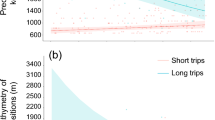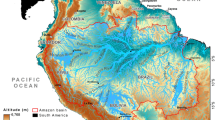Abstract
Life-history trade-offs and the costs of reproduction are central concepts in evolution and ecology. Episodic climatic events such as drought and extreme temperatures provide strong selective pressures that can change the balance of these costs and trade-offs. We used size-structured matrix models parameterized from field and laboratory studies to examine the effect of periodic drought on two species of aquatic salamanders (greater siren, Siren lacertina; lesser siren, Siren intermedia) that differ in size at reproduction and maximum body size. Post-drought body size distributions of the larger species (S. lacertina) are consistent with size-dependent mortality. Smaller individuals were extirpated from the population during each drought while large animals persisted, a pattern that contrasted with that seen in several ectotherms. This appears to be largely explained by estivation proficiency and a positive relationship between body size and estivation potential. Increased body size, however, may come at the cost of fecundity and maturation rate compared to a closely related congener. The cost of somatic allocation in this case may manifest itself via reduced per-capita competitive ability, which (at least in simulation studies) allows the smaller, fast-maturing species to outcompete the larger, slow-maturing species when drought is minimal or nonexistent.



Similar content being viewed by others
References
Bårdsen BJ, Henden JA, Fauchald P, Tveraa T, Stien A (2011) Plastic reproductive allocation as a buffer against environmental stochasticity–linking life history and population dynamics to climate. Oikos 120:245–257. doi:10.1111/j.1600-0706.2010.18597.x
Blueweiss L, Fox H, Kudzma V, Nakashima D, Peters R, Sams S (1978) Relationships between body size and some life history parameters. Oecologia 37:257–272. doi:10.1007/bf00344996
Brose U, Dunne JA, Montoya JM, Petchey OL, Schneider FD, Jacob U (2012) Climate change in size-structured ecosystems. Philos Trans R Soc B Biol Sci 367:2903–2912. doi:10.1098/rstb.2012.0232
Brown CR, Brown MB (1998) Intense natural selection on body size and wing and tail asymmetry in cliff swallows during severe weather. Evolution 52:1461–1475. doi:10.2307/2411315
Brown JH, Sibly RM (2006) Life-history evolution under a production constraint. Proc Natl Acad Sci USA 103:17595–17599. doi:10.1073/pnas.0608522103
Buhlmann KA, Congdon JD, Gibbons JW, Greene JL (2009) Ecology of chicken turtles (Deirochelys reticularia) in a seasonal wetland ecosystem: exploiting resource and refuge environments. Herpetologica 65:39–53. doi:10.1655/08-028R1.1
Caswell H (2001) Matrix population models, 2nd edn. Sinauer Associates, Sunderland
Clutton-Brock TH, Pemberton JM (2004) Soay sheep: dynamics and selection in an island population. Cambridge University Press, Cambridge. doi:10.1017/CBO9780511550669
Congdon JD, Dunham AE, Van Loben Sels RC (1994) Demographics of common snapping turtles (Chelydra serpentina): implications for conservation and management of long-lived organisms. Am Zool 34:397–408. doi:10.1093/icb/34.3.397
Davis WB, Knapp FT (1953) Notes on the salamander Siren intermedia. Copeia 1953:119–121. doi:10.2307/1440144
Dobson GP, Headrick JP (1995) Bioenergetic scaling: metabolic design and body-size constraints in mammals. Proc Natl Acad Sci USA 92:7317–7321. doi:10.1073/pnas.92.16.7317
Etheridge K (1990) The energetics of estivating sirenid salamanders (Siren lacertina and Pseudobranchus striatus). Herpetologica 46:407–414
Frese PW, Mathis A, Wilkinson R (2003) Population characteristics, growth, and spatial activity of Siren intermedia in an intensively managed wetland. Southwest Nat 48:534–542. doi: 10.1894/0038-4909(2003)048<0534:PCGASA>2.0.CO;2
Gehlbach FR, Kennedy SE (1978) Population ecology of a highly productive aquatic salamander (Siren intermedia). Southwest Nat 23:423–429. doi:10.2307/3670250
Gehlbach FR, Gordon R, Jordan JB (1973) Aestivation of the salamander, Siren intermedia. Am Midl Nat 89:455–463. doi:10.2307/2424051
Gibbons JW, Semlitsch RD, Greene JL, Schubauer JP (1981) Variation in age and size at maturity of the slider turtle (Pseudemys scripta). Am Nat 117:841–845. doi:10.1086/283774
Gibbons JW, Greene JL, Congdon JD (1983) Drought-related responses of aquatic turtle populations. J Herpetol 17:242–246. doi:10.2307/1563826
Goin CJ (1947) Notes on the eggs and early larvae of three Florida salamanders. Chic Acad Sci Nat Hist Misc 10:1–4
Hanlin HG, Mount RH (1978) Reproduction and activity of the greater siren, Siren lacertina (Amphibia: Sirenidae), in Alabama. J Ala Acad Sci 49:31–39
Holdo RM, Fryxell JM, Sinclair ARE, Dobson A, Holt RD (2011) Predicted impact of barriers to migration on the Serengeti wildebeest population. PLoS One 6:e16370. doi:10.1371/journal.pone.0016370
Kingsolver JG, Pfennig DW (2004) Individual-level selection as a cause of Cope’s rule of phyletic size increase. Evolution 58:1608–1612. doi:10.1554/04-003
Lindstedt SL, Boyce MS (1985) Seasonality, fasting, endurance, and body size in mammals. Am Nat 125:873–878. doi:10.1086/284385
Luhring TM (2008) Population ecology of greater siren, Siren lacertina. M.S. thesis. University of Georgia, Athens
Luhring TM (2009) Using PIT tags to evaluate non-individual-specific marks under field conditions: a case study with greater siren (Siren lacertina). Herpetol Rev 40:170–173
Luhring TM, Jennison CA (2008) A new stratified aquatic sampling technique for aquatic vertebrates. J Freshw Ecol 23:445–450. doi:10.1080/02705060.2008.9664222
Luhring TM, Todd BD (2010) Siren intermedia (lesser siren). Drought survival. Herpetol Rev 41:60
Luhring TM, Willson JD, Winne CT (2011) Nerodia fasciata (banded watersnake). Inter-wetland movement. Herpetol Rev 42:100–101
Nagel L, Schluter D (1998) Body size, natural selection, and speciation in sticklebacks. Evolution 52:209–218. doi:10.2307/2410936
Nakaoka M (1998) Optimal resource allocation of the marine bivalve Yoldia notabilis: the effects of size-limited reproductive capacity and size-dependent mortality. Evol Ecol 12:347–361
Overpeck J, Udall B (2010) Dry times ahead. Science 328:1642–1643. doi:10.1126/science.1186591
Pearl R, Miner JR (1935) Experimental studies on the duration of life. XIV. The comparative mortality of certain lower organisms. Q Rev Biol 10:60–79. doi:10.1086/394476
Peters RH (1983) The ecological implications of body size. Cambridge University Press, Cambridge. doi:10.1017/CBO9780511608551
Roff DA (1992) The evolution of life histories: theory and analysis. Chapman and Hall, New York
Schalk CM, Luhring TM (2010) Vagility of aquatic salamanders: implications for wetland connectivity. J Herpetol 44:104–109. doi:10.1670/08-312.1
Sever DM, Rania LC, Krenz JD (1996) Reproduction of the salamander Siren intermedia Le Conte with especial reference to oviducal anatomy and mode of fertilization. J Morphol 227:335–348. doi:10.1002/(SICI)1097-4687(199603)227:3<335:AID-JMOR5>3.0.CO;2-4
Sheridan JA, Bickford D (2011) Shrinking body size as an ecological response to climate change. Nat Clim Change 1:401–406. doi:10.1038/nclimate1259
Shine R (1988) The evolution of large body size in females: a critique of Darwin’s “fecundity advantage” model. Am Nat 131:124–131. doi:10.1086/284778
Snodgrass JW, Ackerman JW, Bryan ALJ, Burger J (1999) Influence of hydroperiod, isolation, and heterospecifics on the distribution of aquatic salamanders (Siren and Amphiuma) among depression wetlands. Copeia 1999:107–113. doi:10.2307/1447391
Stearns SC (1976) Life-history tactics: a review of the ideas. Q Rev Biol 51:3–47. doi:10.1086/409052
Taborsky B, Dieckmann U, Heino M (2003) Unexpected discontinuities in life-history evolution under size-dependent mortality. Proc R Soc Lond Ser B Biol Sci 270:713–721. doi:10.1098/rspb.2002.2255
Walls SC, Barichivich WJ, Brown ME (2013) Drought, deluge and declines: the impact of precipitation extremes on amphibians in a changing climate. Biology 2:399–418. doi:10.3390/biology2010399
Wells KD (2007) The ecology and behavior of amphibians. University of Chicago Press, Chicago. doi:10.7208/chicago/9780226893334.001.0001
Werner EE (1986) Amphibian metamorphosis: growth rate, predation risk, and the optimal size at transformation. Am Nat 128:319–341. doi:10.1086/284565
Wikelski M, Trillmich F (1997) Body size and sexual size dimorphism in marine iguanas fluctuate as a result of opposing natural and sexual selection: an island comparison. Evolution 51:922–936. doi:10.2307/2411166
Williams GC (1966) Natural selection costs of reproduction and a refinement of Lack’s principle. Am Nat 169:673–683. doi:10.1086/282461
Willson JD, Winne CT, Dorcas ME, Gibbons JW (2006) Post-drought responses of semi-aquatic snakes inhabiting an isolated wetland: insights on different strategies for persistence in a dynamic habitat. Wetlands 26:1071–1078. doi:10.1672/0277-5212(2006)26[1071:prossi]2.0.co;2
Winne CT, Willson JD, Gibbons JW (2010) Drought survival and reproduction impose contrasting selection pressures on maximum body size and sexual size dimorphism in a snake, Seminatrix pygaea. Oecologia 162:913–922. doi:10.1007/s00442-009-1513-8
Withers PC (1993) Metabolic depression during aestivation in the Australian frogs, Neobatrachus and Cyclorana. Aust J Zool 41:467–473. doi:10.1071/zo9930467
Woodward G, Brown LE, Edwards FK, Hudson LN, Milner AM, Reuman DC, Ledger ME (2012) Climate change impacts in multispecies systems: drought alters food web size structure in a field experiment. Philos Trans Roy Soc B Biol Sci 367:2990–2997. doi:10.1098/rstb.2012.0245
Acknowledgments
R. Semlitsch, S. Pittman, T. Meckley, and G. Connette provided helpful comments on earlier drafts of the manuscript. A. Tucker provided data from 1993 sampling of greater sirens. K. McCleod, and R. Lide provided wetland data. J. W. Gibbons, T. Tuberville, K. Buhlmann, S. Poppy, and the Savannah River Ecology Laboratory provided lab space, academic support, and materials used during parameter data collection. R. Cocroft and the IBM Model Class of 2010 at the University of Missouri provided suggestions and help during initial model development. The Trans-World Airlines Scholarship and Life Sciences Fellowship at the University of Missouri provided financial support to TML during the course of model development. This material is based on work supported by the American Museum of Natural History’s Theodore Roosevelt Memorial Fund (to TML), and by the Department of Energy under Award Number DE-FC09-07SR22506 to the University of Georgia Research Foundation.
Author information
Authors and Affiliations
Corresponding author
Additional information
Communicated by Ross Andrew Alford.
Electronic supplementary material
Below is the link to the electronic supplementary material.
Rights and permissions
About this article
Cite this article
Luhring, T.M., Holdo, R.M. Trade-offs between growth and maturation: the cost of reproduction for surviving environmental extremes. Oecologia 178, 723–732 (2015). https://doi.org/10.1007/s00442-015-3270-1
Received:
Accepted:
Published:
Issue Date:
DOI: https://doi.org/10.1007/s00442-015-3270-1




